








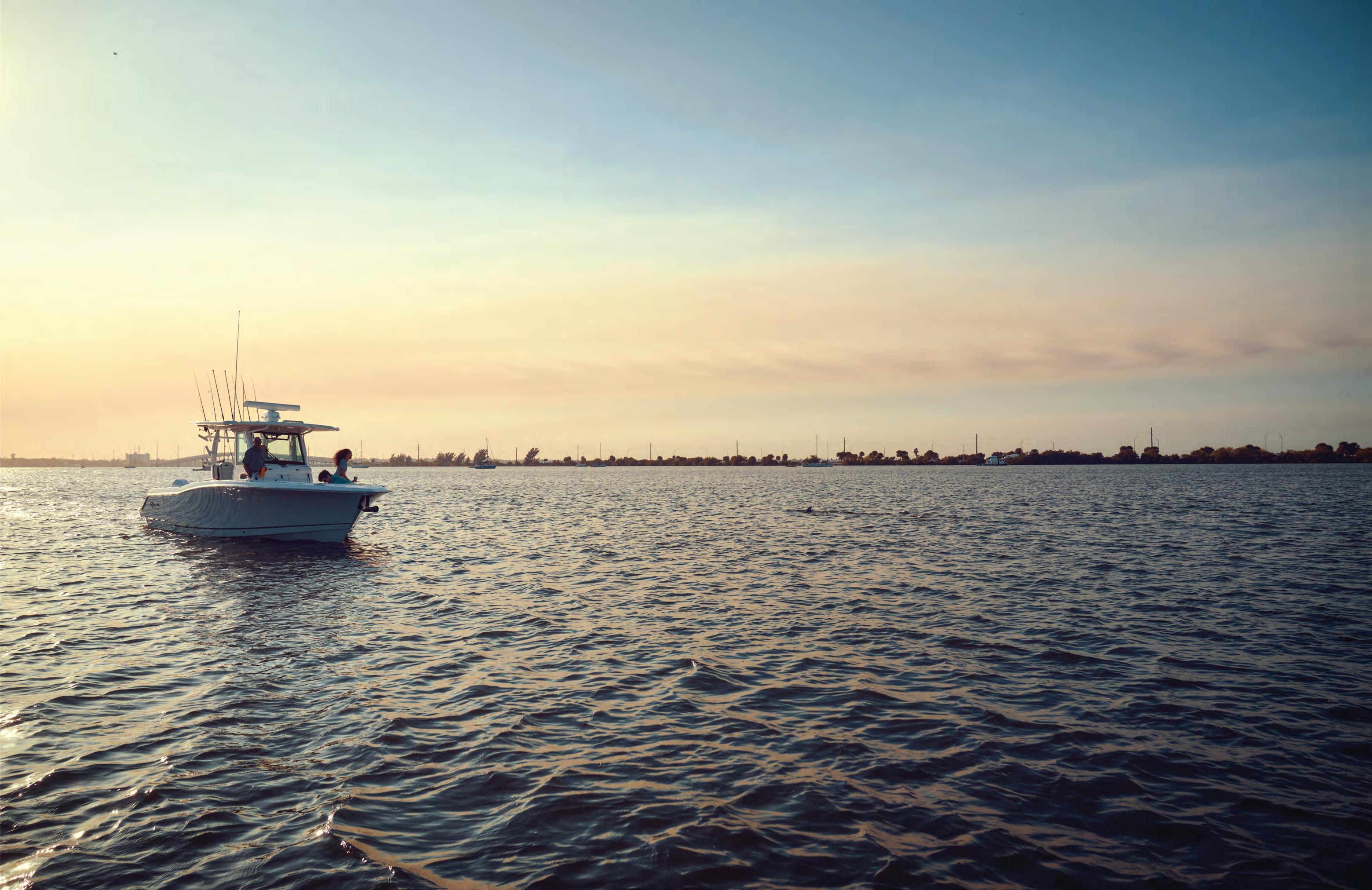
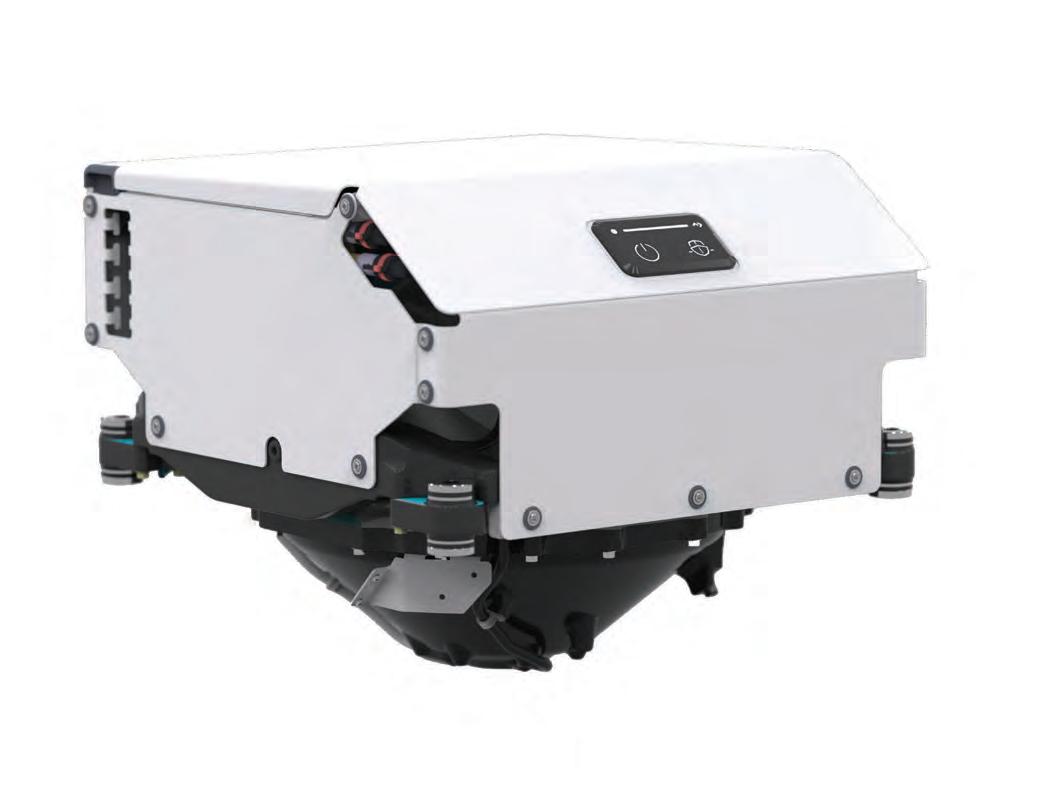












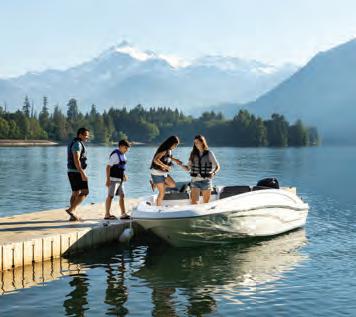






Embarking on the open water is an exhilarating experience, flled with the promise of adventure and relaxation. Whether you’re a seasoned sailor or a weekend cruiser, protecting your vessel with proper insurance is not just a choice—it’s a necessity. Explore the reasons why every boat owner should prioritize boat insurance for a worry-free voyage.
The open water can be unpredictable, with unexpected storms, collisions, or other potential accidents. Boat insurance can give you fnancial protection if there is damage to your vessel, providing coverage for repairs or replacement.
Accidents on the water can result in damage to other boats, docks, or even injuries to passengers. Boat insurance offers liability coverage, which can pay for damages or injuries you’re liable for while boating, up to specifed limits, and lawsuit costs if you’re sued. This includes damage you cause to another watercraft or if someone on or near your boat is injured and you’re found to be legally responsible.
Unfortunately, boat theft and vandalism are realities that boat owners face. Boat insurance has comprehensive and collision coverage that can protect you against events outside of your control, including theft and vandalism.
Accidents on the water may lead to injuries for you or your passengers. Boat insurance offers a range of optional medical payments coverage limits, helping to cover medical expenses if you are in an accident or someone is hurt on your boat, regardless of fault.
If you fnanced the purchase of your boat, most lenders require insurance coverage to protect their investment. Having boat insurance not only fulflls these requirements but also gives you peace of mind knowing that your fnancial interests are safeguarded.


Some water municipalities and marinas may require proof of insurance for docking or accessing certain areas. Boat insurance allows you the fexibility to explore different destinations without worrying about entry restrictions.
Emergency towing and assistance
Progressive boat insurance can include optional Sign & Glide® On-Water Towing coverage. If your boat is disabled or breaks down on the water, Sign & Glide® pays for on-water towing, jump starts, soft un-groundings, and fuel delivery.
Wreckage removal
If your boat sinks, Progressive boat insurance will cover the cost of removing your boat from the water (if removal is legally required).
Investing in boat insurance is not just about protecting a valuable asset; it’s about safeguarding the memories, experiences, and joy that come with your on-water adventures. Don’t let unforeseen circumstances disrupt your journey—navigate with confdence, knowing that Progressive boat insurance has you covered. Ensure a smooth and worry-free voyage, because when it comes to your boat, peace of mind is the ultimate luxury.
Scan to get a quote in as little as 4 minutes
learn more.




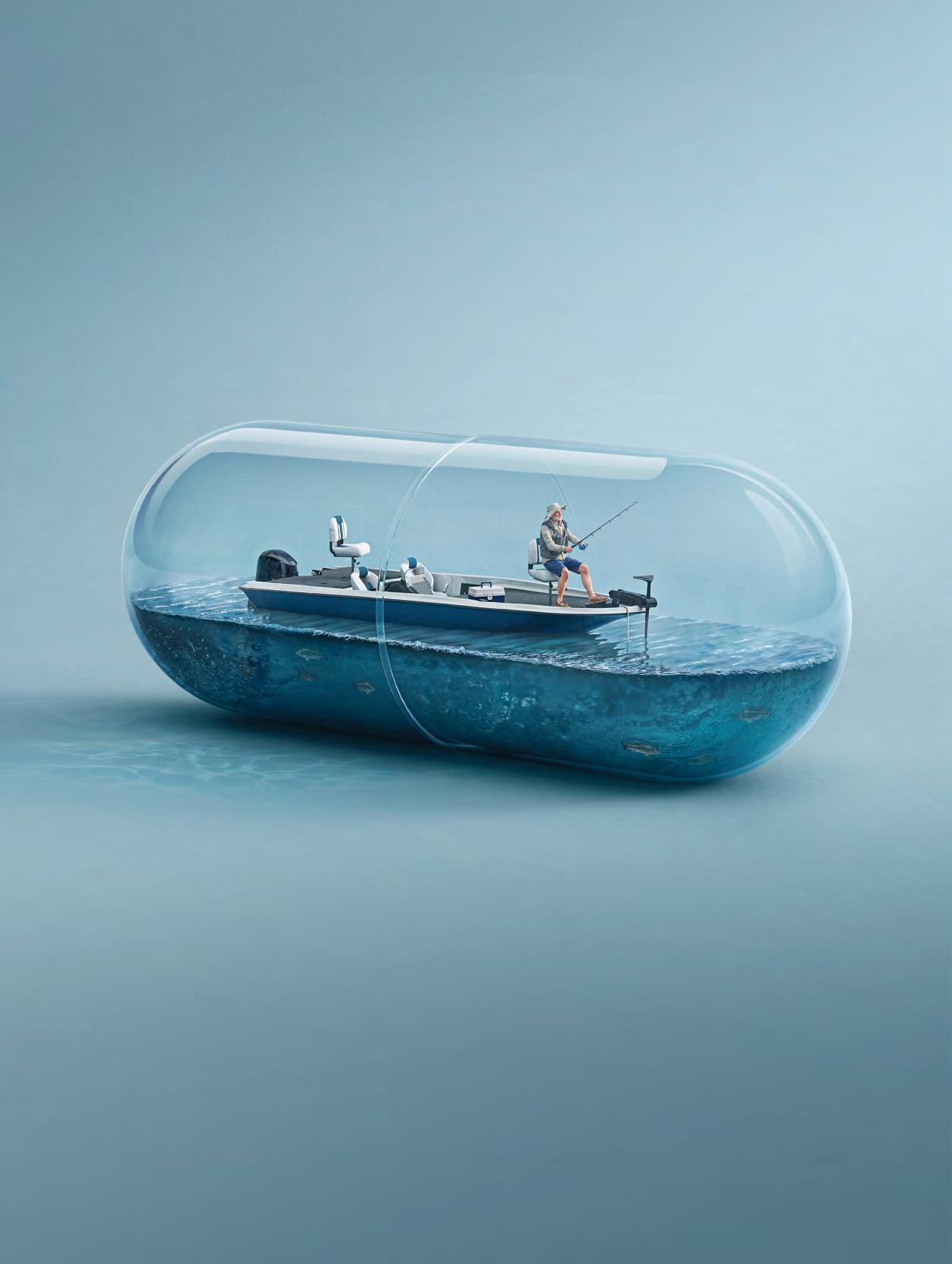
















May is one of my favorite months for o!shore shing, as the shing seasons coincide with good weather. Being spared from the beginning of hurricane season until next month, right now is the most reliable time to get nice weather days to make the trek to deeper waters.
Mahi season has begun to be more consistent, making the trips o!shore more exciting and worthwhile. When making the long drive to the humps for black n tuna, or the sword sh ledges, it’s always a plus to know that you have opportunities to catch mahi on the way there and back. Staying alert for weedlines, diving birds and oating debris makes the trip seem like less of a chore, and keeps that sherman’s optimism alive for more of the venture, knowing you’re still on the hunt nearly the whole way back to the dock.
With the prevalence of mahi, tuna, queen snapper and sword sh in our deepwater shery, May 1st marks the opening of grouper season here in e Florida Keys, providing additional catching opportunities for both nearshore and o!shore adventures. We also welcome the opening of tile sh this month.
For those with an electric reel setup in their arsenal, this is a great month to get out there and scout for new deep-dropping locations. With snowy grouper and yellowedge grouper found peppered throughout the area, test dropping on new found spots can be a fun addition to mahi shing. As you run aimlessly o!shore looking for
signs of dolphin sh, you may notice you run over a ledge or depth variation. Anything that looks shy a%er about 500’ could be your next honeyhole.
By Capt. Quinlyn Haddon
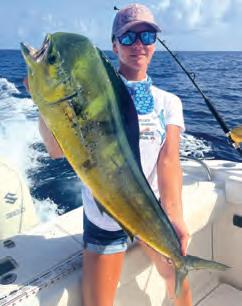
If this is a new area especially, use a variety of baits on your 5-hook deepdrop rig to ensure your best chances of surveying the location. Squid is always a good choice o!shore, with many species unable to resist its potent aroma, but chunks of sh should be included to entice a grouper bite. With bait sizes matching hook sizes, its a good idea to make your own rigs with di!erent sized hooks if you’re unsure of the species that might be available at a new place. A x larger hooks near the bottom of the rig for grouper baits, and smaller hooks near the top with squid for tile sh.
If o!shore isn’t your thing, there are plenty of grouper on the reef and wrecks nearshore this time of year as well. However, a%er releasing these sandwich providers since their closing January 1st, every local sherman in town will be hitting the wrecks hard for the recaptures now that season is open. Before they face all this pressure from being targeted nearshore, particularly on publicly known wrecks, it’s a good time to put some skin in the nearshore grouper game.
A%er a short closure for the month of April, amberjack has also opened again this month.
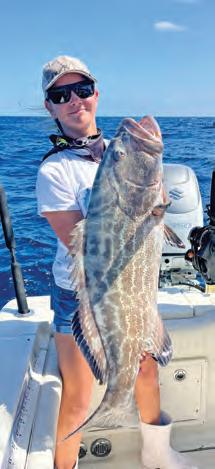
ese sh are easy to nd, and add some nice backbreaking action to the grouper hunt.
Whatever your avor of shing is, e Florida Keys has you covered this month. With the anticipated opening of grouper season at the beginning of May, and schools closing for summer break nearing the end, it’s a good idea to get booked for a charter before you arrive on your Keys vacation.
Give us a call at Sweet E’nuf Charters to get tight.
Capt. Quinlyn Haddon guides with Sweet E’Nuf Charters out of Marathon, e Florida Keys. (504) 920-6342. www.captainquinlyn.com; IG: @captainquinlyn
Whether you’re chasing trophy fish or charting your next offshore course, your time on the water deserves the best in navigation and marine technology. Defender brings you UNBEATABLE PRICES and EXPERT SUPPORT on Lowrance and Simrad electronics—trusted by professionals and weekend warriors alike.


and navigation that keeps you locked on target.

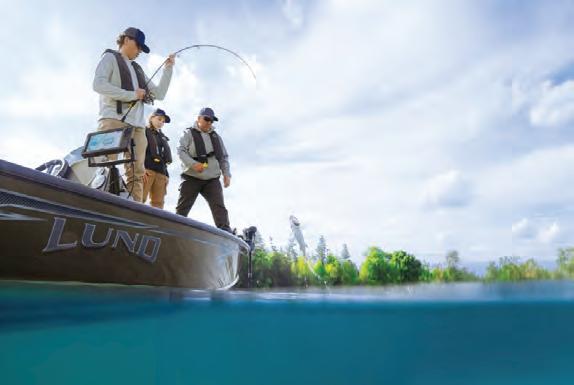

No ofense to those nifty little knives that the Swiss pack a kitchen into, but sometimes it takes a big blade to get the job done. Tat was the case three years ago when I found myself in the jungles of Argentina.
I’d heard a tale about lost Inca gold and was on the hunt for clues. Among other things, the Inca were known for their extensive road system that ran at least 25,000 miles along South America’s eastern side. But the clue I was looking for was down a long-abandoned road overtaken by jungle.

Join the over 492,000 sharp people who own Stauer knives
That’s when my Pathfinder Blade came to the rescue. Constructed of high-quality 420 surgical stainless steel and with a total length of 16 inches, this full-tang knife made quick work of the jungle brush. And with its rugged handle of genuine, natural white bone that’s been hand-carved and torched with an iconic design, I didn’t lose my grip. Rounded off by brass spacers, handguards, a brown pakkawood handle, and hand engravings on the blade’s spine, this baby is all you could ever handle in jungle brush.

Upon reaching a stone wall hidden by the jungle, I snapped my knife back into its tooled genuine leather sheath and read the markings the Incas had left long ago. It was time to travel north for the next part of my adventure.
To make your next adventure even better, we’re including a pair of Stauer Flyboy Optics® Sunglasses— a $99 value—FREE with your purchase of the Pathfinder Blade. Lightweight, and ready to go wherever you do, these sunglasses are the perfect companion to help you stay sharp on the trail.

Flyboy Optics® Sunglasses a $99value with your purchase of the Pathfinder Blade




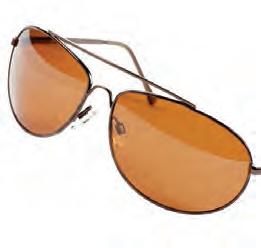



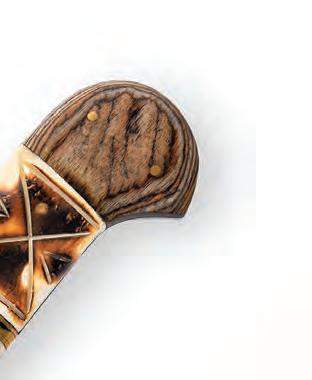
What Stauer Clients Are Saying About Our Knives
“This knife is beautiful!” — J., La Crescent, MN Knife Specifcations:
• 16" total length.
• High-quality 420 surgical stainless steel blade
• Full-tang construction. Handle of genuine, natural white bone that’s been hand-carved and torched

• Brass spacers and handguards, brown pakkawood handle, and hand engravings on the blade spine
• Leather sheath included Pathfinder Blade

$349 $99* + S&P Save $250
California residents please call 1-800-333-2045 regarding Proposition 65 regulations before purchasing this product.
*Special price only for customers using the offer code.



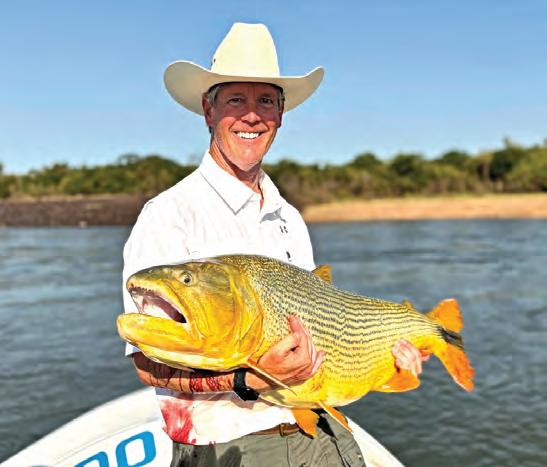


By Riley Love

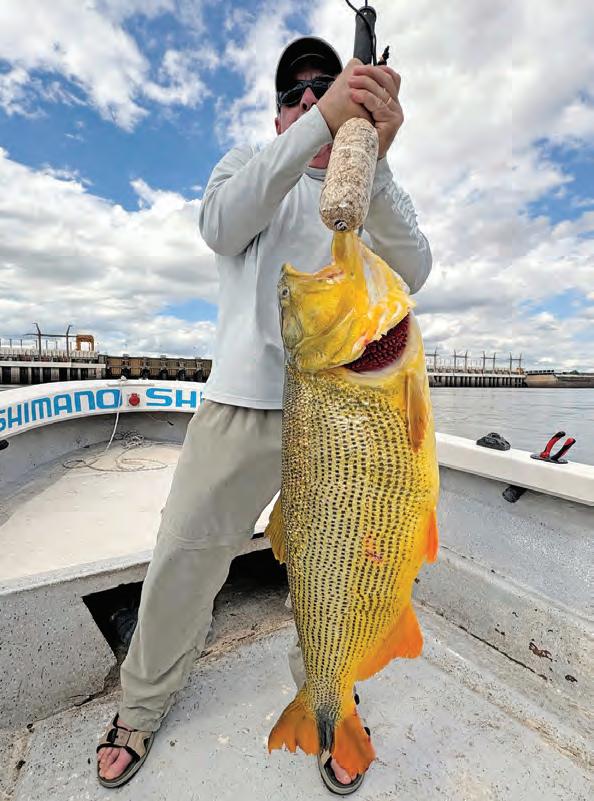
nly in the dreams of shermen does this occur. A wondrous game sh pursued across ve countries not only awaits but the biggest, baddest, best of them lay for you in a single place.
e Salminus Brasiliensis is certainly not related to salmon, but is of the order Characiformes which includes many species— notably vampire-fanged payara and modern cinema star piranha in South America and tiger sh in Africa. Redundantly named the golden dorado (dorado means “golden” in Spanish), it’s immensely powerful, acrobatic—and magni cently beautiful.
e Rio Uruguay (indigenous Guarani interpretation “bird river”), with the northern border of Argentina and southern of Uruguay, sports a massive hydroelectric dam, the “El Salto Grande.” Stunned eels and bait sh ow through the locks in highly oxygenated water to the waiting predators. Permits are required by the dual operators on the Argentinian and Uruguay sides of the river to sh within 1,000 meters from the dam. Fishing is rigidly structured into slots of three hours quartered per weekdays per group of two or three anglers in two boats in this “Zona.” e Argentinians lost their permits recently and our two cra% had the entire area to ourselves. Downstream, twenty other boats oated outside the zone a kilometer away, prohibited from approaching nearer. My inner voice asked, “How o%en does this happen to me?”
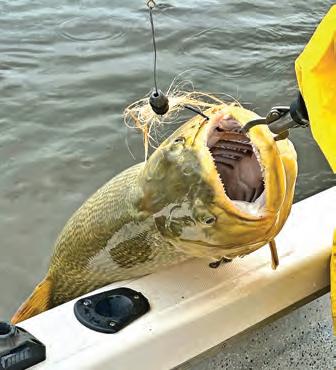
ere are a lot of places to sh for golden dorado in Argentina, Bolivia, Paraguay, Uruguay and Brazil. One would note that the world record is a bit cloudy; there is a 70 lb. specimen claimed in 1970 but without a veri cation or a photo. To re ect on the quality of this shery, the current IGFA record is just over 55 lbs. and taken at La Zona. Our group landed numerous sh into the mid-40 lb. range, within 80% of the documented record. In contrast, the renowned, luxurious golden dorado destination, Pira Lodge, gets about one sh over 30 lbs. annually. shermen do well here. Locals target carp-like boga both for live bait and food. Using large topwater poppers, Rapala style diving minnows and handmade jigs, we hit rocky structure and fastmoving torrents. e dorado were exceedingly sensitive to water levels and ow being released from the dam. When it happened and their buttons were pushed, it was double digit trophies in each time slot. Multiple hookups were common.

Fishing teaches us lessons about life. Whether love, war or business, if you want success you need multiple opportunities. Even with shoulder- wrenching, reel-screaming strikes and Hank Aaron grade roundhouse hooksets, over half of what seemed like solid hookups would suddenly vanish from the transaction. It’s very much like trying to land large toothy- jawed payara. e modus operandi of these golden hulks revealed that even extra strong hooks were straightened, sometimes pulled from the lures; 65 lb. braid and wire leaders were broken. But some just “Houdinied” away, still waiting for you to come, instead of only dreaming.
Justi Campa of Fly Fishing Patagonia assisted with our planning. Reach them by emailing jcampa@ y shingpatagonia.com or visit www. y shingpatagonia.com.

Riley Love is a physician and author with homes in Kentucky and Key Largo, Fla. He has penned dozens of articles on international sport shing and a host of screenplays. He is a member of the International Game Fish Association, e Bill sh Foundation and the Outdoor Writers Association of America. Contact him at 270-816-4423, rjhclove@gmail.com or visit his website: rileylove.com.




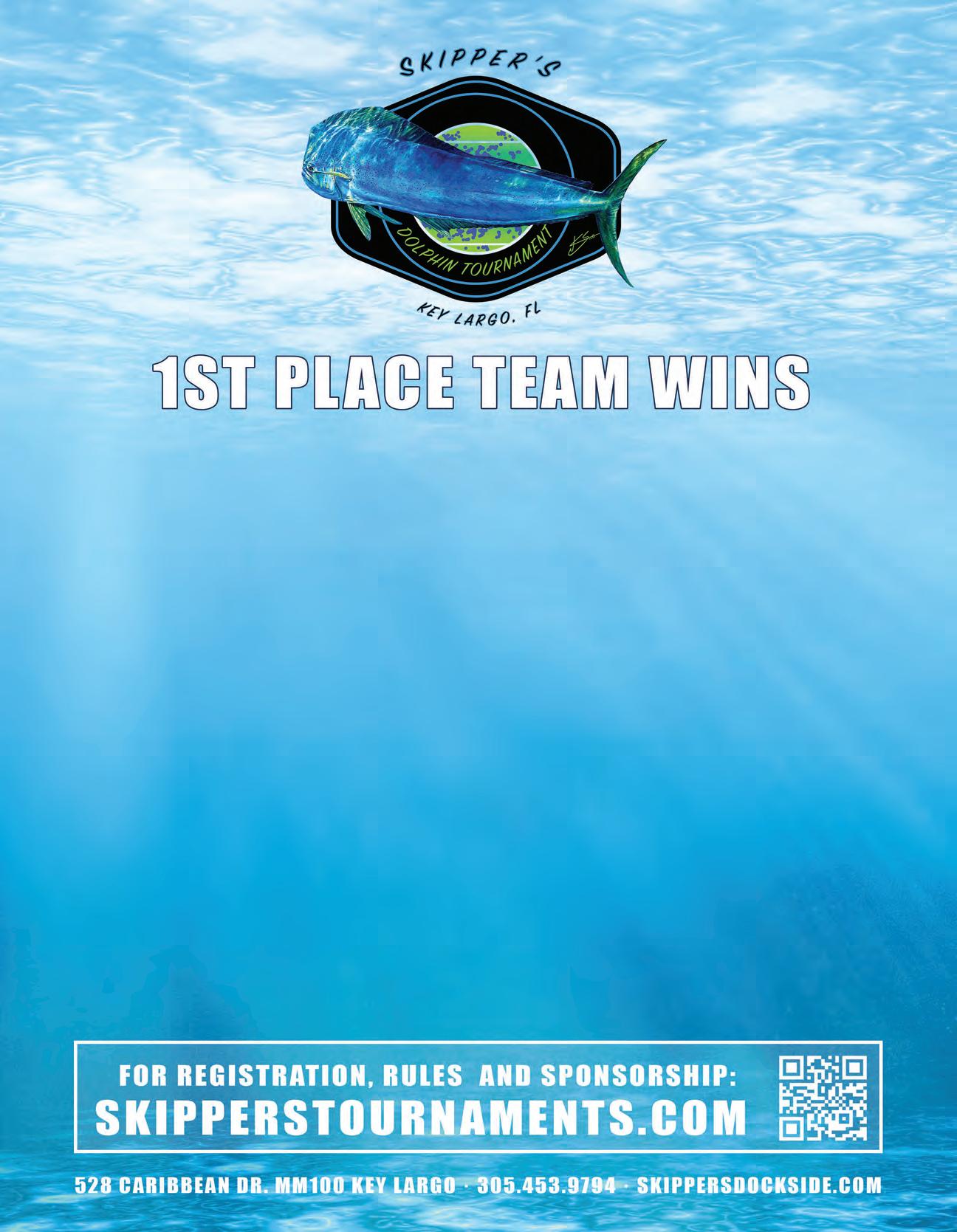

brooks@coastalanglermagazine.com


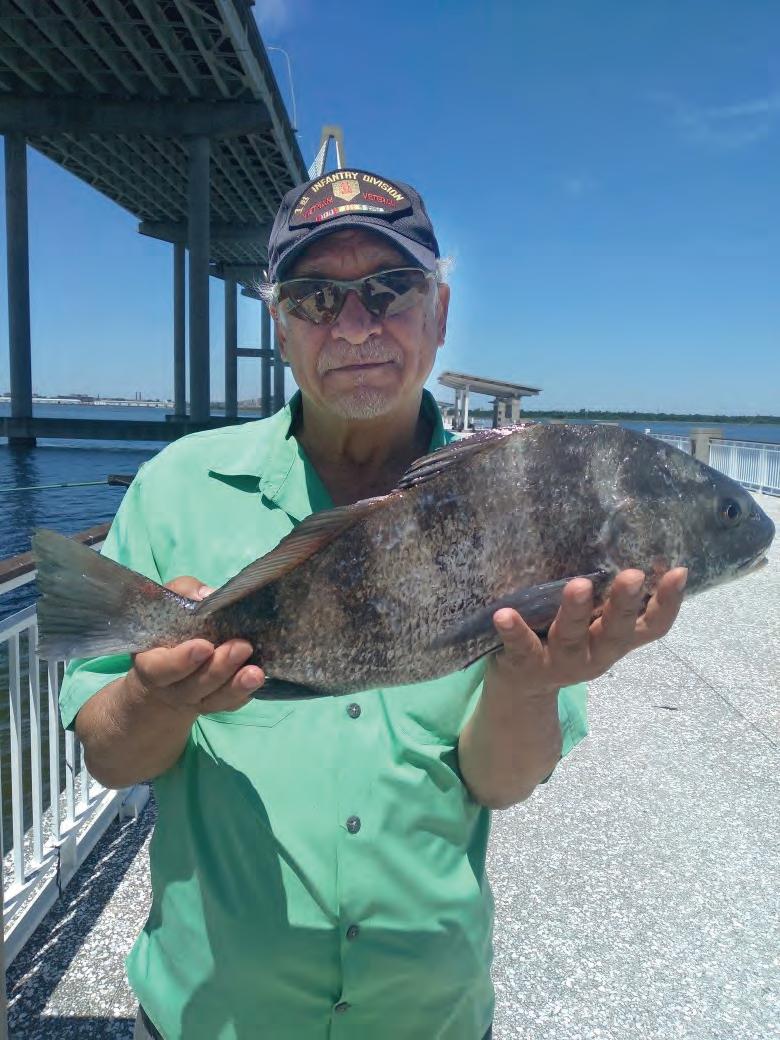

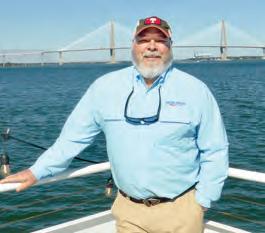




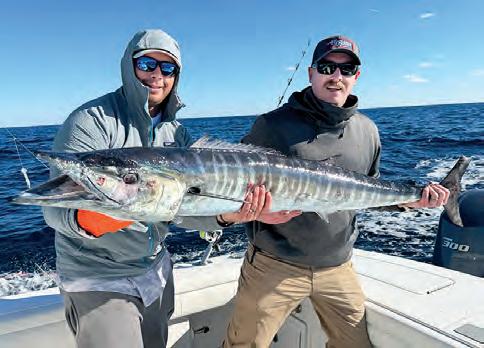
by Capt. Mike Able, Contributing Writer
The month of May really does bring a lot of organized chaos to the table! And all good things at that! From school graduations to the idea of summer just right around the corner, there are a number of good things that happen this time of year.
You can especially get excited for whats to come on the inshore fishing side of things. The water starts to warm up, the weather can tend to be more stable, and more species become available for us to target. You will start to see more species like spanish mackerel, more flounder, jack crevalle, tarpon, sharks, ladyfish, and bluefish and more. The hard part about the spring is the ever changing weather and now that we’ve got a more stable pattern, you should start to be able to pattern these fish a little easier, with what they are biting, when you caught them in the tide, and what type of rig. I would start off my day at first light throwing topwater plugs. If the tide happens to be high that morning, it may be more of a topwater trout bite, but if it’s half outgoing or low incoming get ready for that huge redfish to blow up on your plug. One of two baits are needed: a super spook jr in your color choice(I like silver mullet or the trout pattern) or doing the Rapala SkitterV in pink. Taking a 7’ med light action rod with ten pound braid, two feet of twenty pound flourocarbon leader, tied off with a loop knot and you are in for some success. Make sure to watch our video on our website to make sure you have the proper action in the topwater plug. As the sun comes up the topwater bite will slow and you can transition to something else, whether it be an artificial shrimp or a live bait under a float. Use about thirty inches of twenty pound leader to connect the float and the bait. Pay attention to the water clarity as switching your bait color will be a necessity. Dark water, use darker colors. Clearer water will call for more translucent colors. In both situations don’t forget to add scent like pro-cure and even put a rattle in a shrimp!
By now the most of that warmer gulf stream water has started to push in shallower offering mahi mahi in abundance along with the usual suspects of tuna, some wahoo, and billfish. Trolling the ledge in that 150-200’ of water over bottom structure or relief will typically yield fish in the meat category. Finding weedlines, temperature breaks, and good signs of bait can mean you are bound to find a hungry fish! A typical trolling meat spread for me consists of a cedar plug four zip codes behind the boat on your center line, ballyhoo on the long riggers, Nomad DTX on the flatlines, and dealers choice on your shorts.
When looking for billfish a lot of the same attributes you'd look for meat fish can be ideal for billfish, just typically in slightly deeper water. Trolling ballyhoo is common practice, along with teasers to draw them up. If you’re setup properly you can also troll dredges(another form of a teaser) to really increase your chances. A lot of center console boats now have that capability to do so when rigged accordingly. We’d be happy to set you up with those, to really increase your chances of catching billfish and meat fish.
Continue to check us out on our Facebook page as we share more tips and techniques for all the diverse fishing stuff we carry in the shop! We also do a fishing report each Thursday afternoon on the local ESPN radio show with Bobby Hartin. Whether you are wanting to catch a bream or a blue marlin let our expert employees help you get setup. We would be happy to assist with outfitting a boat, setting you up with new rod and reels for specific fishery, and even rig some lures for you!
Capt Mike Able
Haddrell’s Point Tackle & Supply • Since 1983
843-881-3644(Mt Pleasant) • 843-573-3474(West Ashley)

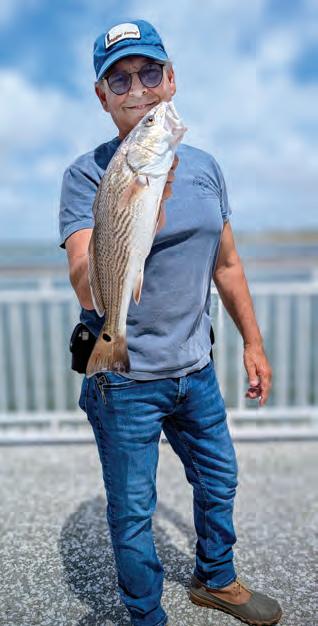



by Jiggin’ Jerry, Contributing Writer
Spring is here. Temperatures in the Lowcountry move up and down, a little warm in the afternoons and cool in the evenings. Everyone that loves to fish is eager to get out on the water with these lovely temperatures, but when it comes to inshore fishing, not everyone knows what bait to use. In fact, it’s one of the most asked questions that I hear, so let’s talk about the most common bait used to catch some of the most common inshore fish by the avid angler.
The first and number one bait, and one of the most common here in the Lowcountry, is frozen shrimp. Frozen shrimp can be considered a catch-it-all bait because, honestly, frozen shrimp will do just about that. The trick to using frozen shrimp is using the proper rig and hook size for the fish that you are targeting. For example, taking the kids fishing either during one of their days off or summer vacation can be great, but keeping their attention and having them catch fish is another story. Frozen shrimp can help you turn a fishing trip into a catching trip in the right location.
The first thing that parents or any adult likes to do when it comes to setting up a fishing rod and rig for a child is put a heavy weight, two large hooks on a double bottom rig, throw on two whole pieces of shrimp with the shell on and throw it as far out as they can, hand the rod to the child and hope for the best. In most cases, the child will keep reeling the rod in and checking it and, as he does, the piece of shrimp grows smaller and smaller until the Shrimp is gone and the rig has to be re-baited.
Sometimes they luck out and a stingray grabs the shrimp or an unexpected game fish decides to partake, but the one thing that’s great about children when it comes to fishing is they get excited over anything they are catching. pinfish, whiting, croaker and spot are considered trophies to them, as a smile stretches from ear to ear, as they swing their rod left and right, almost tap dancing with glee to show you their wonderful achievement. If they catch five or six in a row, get ready because they are about to give you advice on how mom or dad, or whomever is helping them, how to catch a fish! To put this in motion, just think small, a little finesse can go a long way. First, let’s make them a rig, and we’ll start with a Carolina rig. An egg weight no larger than ½ ounce will suffice, one small bead, a swivel, not rated higher than 15-pound test, a piece of fluorocarbon leader in 12-pound test and at least 12 inches long, and an octopus hook in a size 6 will do nicely. For the shrimp, you want to take the tail piece of the Shrimp, make sure it is thawed fully if it was frozen, peel off the shell and cut the shrimp up in quarter inch pieces. Take the small #6 hook and lace a piece of the shrimp from the side onto the hook then, instead of casting way out away from you, target locations that have structure or small eddies developing from current and drop the rig into the eddy or close to the structure. This will be a good place to target the small species of fish that I had mentioned above, but don’t be surprised if something larger grabs that rig. I have seen Black Drum as big as 25 inches grab that small piece of shrimp, including 16-inch spotted seatrout, black sea bass, etc.
Live shrimp works fantastic year round when you can get it. Live shrimp here can be purchased from some tackle shops here in the Lowcountry. They can be used on a Carolina rig, drop shot rig or under a popping cork. The main trick is to make sure that you hook the shrimp correctly, enabling the Shrimp to stay alive for its presentation. Live shrimp are loved by everything, of course, but the inshore slam—red drum, spotted seatrout and flounder—are usually the targeted species by local anglers.
Another popular bait that can be purchased live from some local tackle shops is mud minnows. Mud minnows can be used to target the inshore slam. They help to avoid being grabbed by other small species of fish that can become a nuisance when you are targeting a larger species. In other words, pinfish, whiting and croaker might nip at them, but they are usually engulfed by the larger game fish.
Finger mullet can be found frozen at some local tackle shops. They can be used cut up and tossed out on drop shot rigs or Carolina rigs and can catch a number of fish species this time of year. As we move into summer, finger mullet will start entering our harbors, creeks and rivers. Live finger mullet cannot be purchased at our local tackle shops but an experienced angler can throw cast nets at these fish and catch them live and then are put in aerated buckets to keep them alive. Finger mullet is a fantastic bait in the Lowcountry during the months that they are here. A lot of our game fish will be feeding on them, using them on a drop shot rig, a Carolina rig or under a popping cork will target just about any predatory fish species looking for them. So if you have experience with a cast net or you want to try your luck and pick a cast net up and give it a try, live finger mullet will be one of the top baits to use when inshore fishing in the Lowcountry.
YouTube Channel Fishing With Jiggin Jerry or follow me on Facebook @fwjigginjerry
I hope this helps, and like I always say, good luck out there and have fun fishing!

by Jacob Cynar, Contributing Writer
he warm weather has returned! April and May are the kickoff months for the saltwater fishing season. There is nowhere better than the Folly Beach Fishing to get in on the action! The water temperature has been getting warmer over the past couple of months, which means the fishing is about to start ramping up. This time last year the pier experienced some heavy winds and bad weather that put a damper on the fishing. So far, the weather this spring has been fantastic and we are having plenty anglers take advantage of it.
In March and April, the catch of the month was whiting, and with them, a variety of other fish are following. Typically, May is the month that our speckled sea trout and Florida pompano make their return to the pier. Just past the diamond, you can find king mackerel and Spanish mackerel beginning to return as the waters warm up. In the surf zone, red and black drum will be hunting baitfish to give them a jumpstart for the summer. Live bait usually has the best luck, but frozen bait will always do the trick! The pier gift shop stocks frozen mullet, scented squid strips, and shrimp. It’s your one-stop shop for all things pier fishing—whether you need frozen bait, new tackle, or even a new rod. Make sure to stop in and say hi!
We look forward to seeing our regulars and welcoming any new anglers who want to check out what the pier has to offer. Just a quick reminder: we do not allow fishing after sunset, even though the pier stays open until 10 p.m., and shark fishing is still prohibited. Be sure to join us for our first Cast-Off Fishing Tournament on May 10th! The tournaments start at 6am and end at 2pm. For those interested in music and dancing, we encourage you to come out to our Moonlight Mixers on select Fridays throughout the summer!

Jacob Cynar, Operations Manager II
Folly Beach Fishing Pier
101 E Arctic Ave, Folly Beach, SC, 29439 Office 843.762.9516 Cell: 843.327.0321
Jacob.Cynar@ccprc.com


By Katie Jo, Pluff Mud Princess Outdoors
Irecently hosted a Fishing 101 Event with Nautical Boat Club in Mount Pleasant, SC where the emphasis of the event was on Learning, Fishing and having Fun!

We started the day focusing on the ins and outs of fishing 101 including rod/reel anatomy, line types, casting, fishing knots and two great rigs for catching more inshore fish. The ole trusty Carolina rig and the versatile poppin’ cork, with both rigs being great for live bait.

And once everyone was feeling skilled and confident from the class, we hit the beautiful Wando River on two of Nautical Boat Club’s gorgeous and well-equipped center consoles for a day of fishing, I know we will all never forget!
As we pulled up to the fishing spot that Capt. Kaleb Sherlin of Captain Kaleb Charters had recommended, I could tell we were in for some rod-bending action. Because if anybody knows the Wando River like the back of their hand, it must be Capt. Kaleb. And his willingness to help me with these awesome fishing events at Nautical Boat Club just gives these events a next level of fun and skill building.
And from the first redfish & trout caught by our young anglers to the close to 30” redfish caught by the gentlemen on our boat #2, there was no shortage of incredible memories and great catches by all who attended. With multiple inshore species caught including redfish, black drum and trout. With all anglers either catching their first of these species or their biggest. It was a tremendous day on the water, that I know I for one will never forget.
Thanks to Nautical Boat Club for supporting these awe inspiring Pluff Mud Princess Education Events.




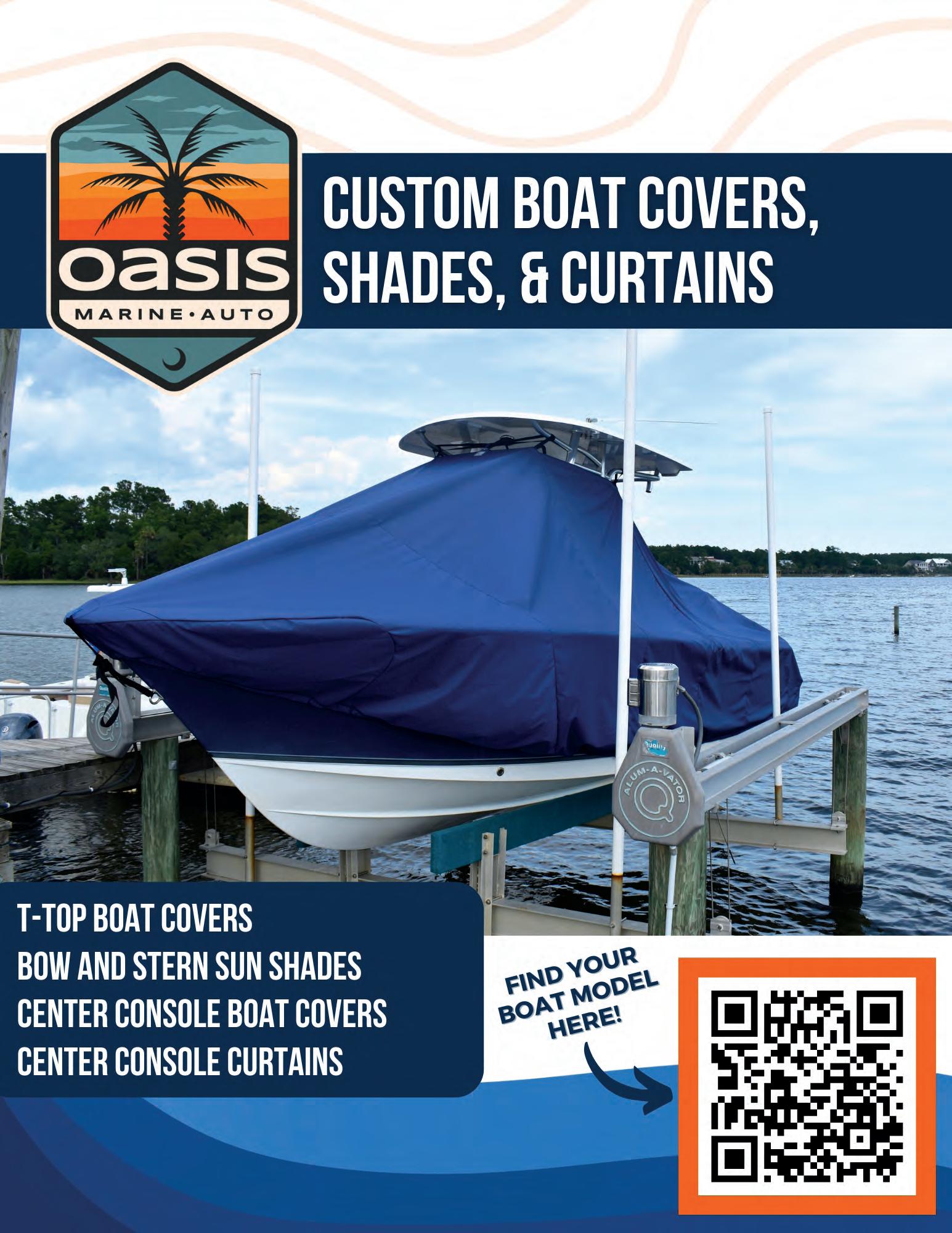


by Chris Pounder, Contributing Writer
ay is a great opportunity to try something new and possibly introduce youth family members to the world of Charleston pier fishing. As the water continues to warm up, so does the bite. Many youth fishermen don’t care what they catch. Their excitement is in seeing something come out of the water, over the rail, and flopping on the deck. Some of the happiest moments I’ve witnessed on the pier involve kids catching puffer fish and being mesmerized as the fish puffs itself up. It’s not always about the trophy catches.

To help that youth angler get “hooked” on the sport, a great place to start is with small hooks like a Sabiki rig. You can pick these up at the River Watch Café & Gift Shop on the pier or at your favorite local tackle shop. Sabiki rigs come ready to go so all you have to do is tie them onto your existing fishing line and drop them over the side. Be ready to watch the excitement as the kids get into pinfish, grunts, perch, and puffers that hang around the pilings. Chunks of squid or shrimp work very well with this setup. Whether you’re catching these fish for bait or just for fun, it’s something the whole family can do together.
For anglers looking to target something a little larger, May should have something for everyone. We expect to see schools of mullet return to the Charleston Harbor and with bait comes the predators. Anglers should expect the usual mix of red drum, flounder, and sheepshead to continue. Bluefish, Spanish mackerel, and even pompano show up around this time of year as well. It’s time to dust off those reels, clean out that tackle bag, and come give it a shot.
Don’t miss the first Cast-Off Fishing Tournament of the year on May 17. Tournament runs from 6am to 2pm with onsite registration beginning just before 6am. The tournament fee is just $5 plus the daily fishing rate. Prizes will be awarded for the top 3 fish by weight, as well as the aggregate weight of 5 fish, and the top youth catch (for those 12 and under). The first 75 anglers will receive a free T-shirt with tournament entry! Be sure to check out charlestoncountyparks.com for information about tournaments and other happenings in your county parks.
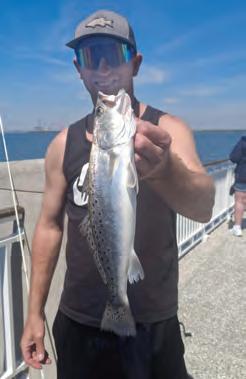
For any additional information about the pier or what’s biting this week feel free to call the River Watch Cafe & Gift Shop on the pier at 843-762-9946
Chris Pounder, CPRP Manager Mount Pleasant Pier

May 7-10
Charleston Billfish Invitational
Seabreeze Marina
Info at www.govcup.dnr.sc.gov
May 10
Folly Beach Pier
Cast Off Fishing Tournament
6 am-2 pm Charleston County Parks
Multiple Prize Categories
More info at wwwccprc.com
May 10
Youth Fishing Rodeo
Goose Creek Municipal Center Pond 9:30-11:30 am
Free event, 15 years old or younger In partnership with SCDNR
May 17
Mt. Pleasant Pier
Cast Off Fishing Tournament
6 am-2 pm Charleston County Parks
Multiple Prize Categories
More info at wwwccprc.com
May 21-24
57th Annual Georgetown Blue Marlin Tournament
Georgetown Marina
Info at www.govcup.dnr.sc.gov
May 28-31
HMY Lowcountry Cup
Toler’s Cove Marina
Benefitting Captains for Clean Water
Info at www.govcup.dnr.sc.gov
June 5
Huk Charleston Cobia Cup & Huk Charleston Billfish Cup
Hosted at Saltwater Cowboys on Shem Creek
Registration and Information at www.charlestoncobiacup.com
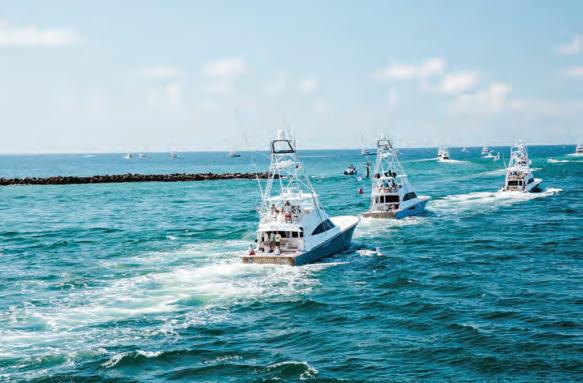
Submit your upcoming events or tournament Info to: brooks@coastalanglermagazine.com
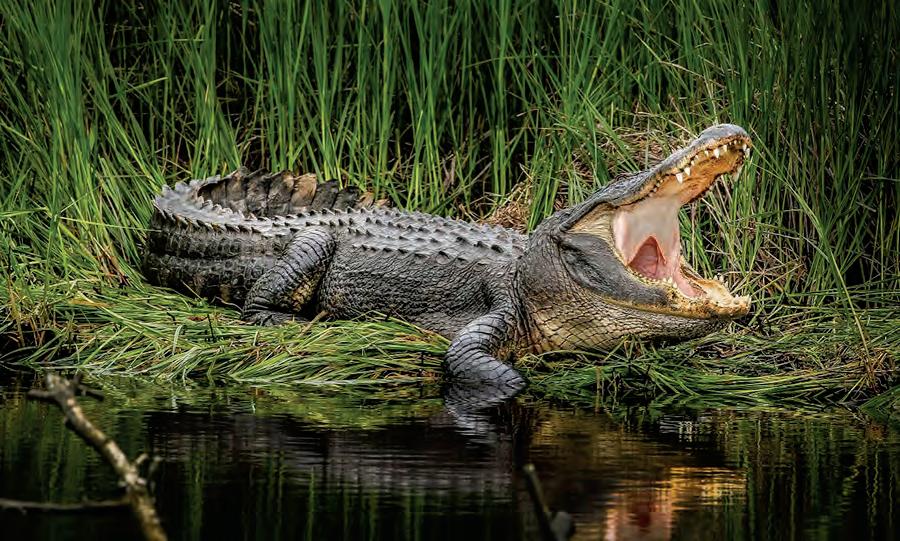
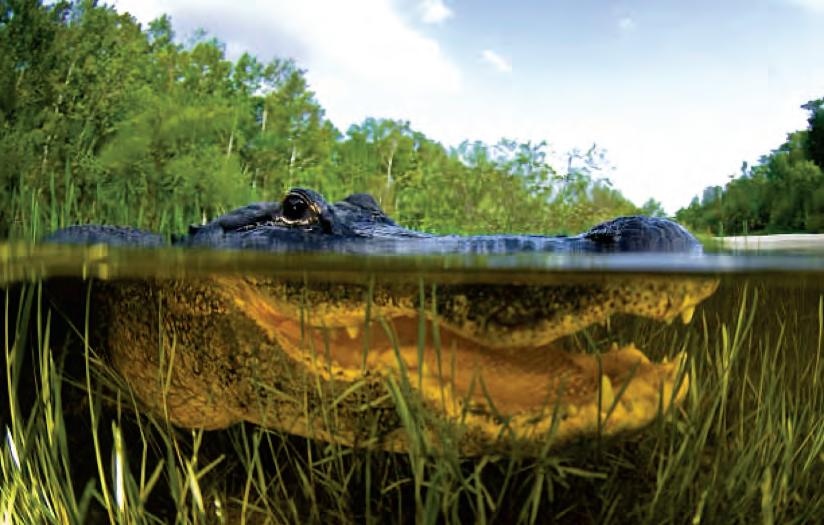
MT. PLEASANT
Mt. Pleasant Pier Pitt St. Bridge
BEACH Folly Beach Pier Folly River Park
JAMES ISLAND Bowens Island Sol Legare Sunset/Demetre Park
WEST ASHLEY
Higgins Pier
West Ashley Greenway West Ashley Park Northbridge Park
DOWNTOWN
Waterfront Park Pier
Colonial Lake
Alberta Sottile Lake Brittlebank Park

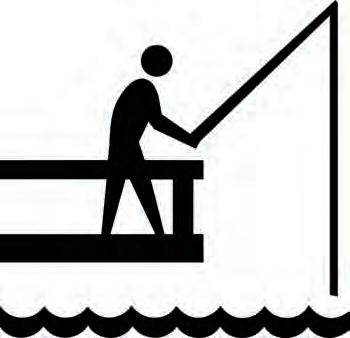

by Capt. Justin Ravenel, Contributing Writer
As much as I love fishing and all things fishing related; I also have a deep appreciation for all our marine biology. Being on the water most of the year provides a chance to see things the average Charlestonian might miss. That’s why I recently opened up my second company “Edisto Dolphin Tours”.
As you can see from my logo above the tours aren’t centered on dolphins entirely. While our local bottle nosed dolphin population are visible all year long; our alligators typically come out in numbers during the warmer months.
These “Lowcountry Dinosaurs” can reach lengths upwards to 14 feet! They prey on turtles, fish, mammals and anything else they can fit in their mouths. Once when I was younger, my now wife and I were cruising down the river when we noticed something floating alongside the bank about 75 yards away. The color and shaped clashed with my intuitions about other possibilities such as stumps or gig clumps of mud and debris. I asked Eliza to take the helm while I walked up to the bow to get a better look. As we approached a little closer I realized what I was looking at. A big hairy, bloated deer carcass was floating just a few feet off of the bow. While keeping my gaze upon this brutal scene, I yelled back to “go ahead and pop her in reverse, it’s a dead deer”. In that moment the entire carcass violently ripped down underneath the black water and disappeared in a way that made my skin crawl and my soul shake. Needless to say I sat down pretty quick and we left the scene.
During the spring these toothy predators are known to be a bit more aggressive due to rutting and mating. Females will be making nests soon and laying eggs as well.

Just last year there was a Lowcountry man attacked by one of our local reptilian residents. While diving in brackish water, he was brutally bitten and dragged some 20 feet down to the bottom where he had to fight for his lifer with nothing but a hand tool. Luckily he escaped with some broken bones and a story that’ll get a free beer at any bar in the United States.
If you are interested in seeing the animals in their natural habitat or if you would like to take the family on a little local gator adventure please contact me by phone or by text. We offer online booking as well at www.EdistoDolphinTours. com. We offer two hour trips and we can take up to 12 people by utilizing two boats. Both of our boats offer plenty of room for the entire family. Check us out on Google as well so you can read some of our reviews! If you are interested in booking a fishing charter instead call me or book online:
Captain Justin Ravenel
RavenelFishingCharters.com
843-864-5056
Facebook: "Ravenel Fishing Charters"
Instagram: @justin_ravenel





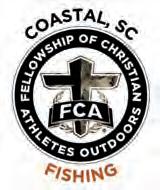
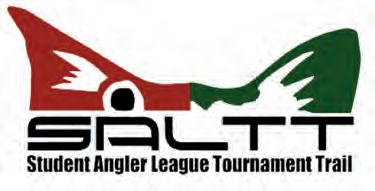
• 1st Mia Mainero of Georgetown with 1 fish at 3.62 lbs. which was also Big Fish
• 2nd Russ Glover of Murrells Inlet with 1 fish at 3.55 lbs.
• Russ Glover was our season Division Champion
• Mia Mainero was our season Points Champion MIDDLE SCHOOL REDS
• 1st Robert Peace of Low Country Prep with 2 fish at 7.68 lbs and Big Fish 4.07
• 2nd Cole Steele and Porter Walser from Winston-Salem with 2 fish at 6.76 lbs
• 3rd Bryce Reeves and Channing Davis from Andeson with 2 fish at 5.49 lbs
• Bryce Reeves and Channing Davis were the Division Champions
• Elliott Johnson and Mason Piver ( Conway ) were the Points Champions
HIGH SCHOOL REDS
• 1st Aden Day and Ayden Rouhselang of Conway with 2 fish at 8.52 lbs. Plus Big Fish at 4.27
• 2nd Callie Calhoun and Corbin Todd of Conway with 2 fish at 5.32 lbs.
• Aden Day and Ayden Rouhselang won the Division and Points Championships

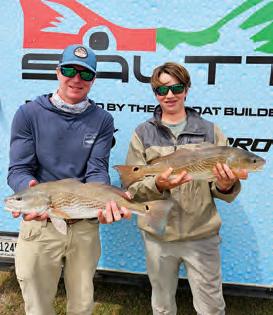
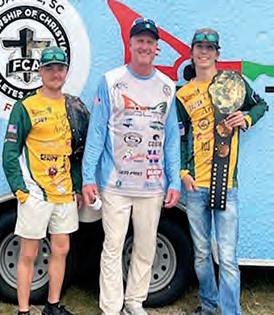
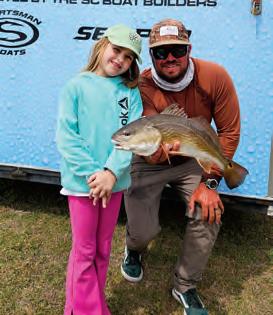
Smiles from our final Georgetown Weigh In Tourney, which is possible due to the generosity of our partners.
This final event provided over $8,000 worth of gift cards, belts, awards, and fishing items to the kids. This championship crowned division and point champions. The division is based on the best total weigh of 3 of the 4 tourneys. Points are awarded each tourney if you make weigh-in so finishing first is ten points, second is nine and so on.
• 1st Garrett Anderson and Jackson Smalls of Conway with 5 fish at 7.20 lbs Plus Big Fish at 1.87 lbs
• 2nd Landon Butler and Maddux Byars of Georgetown with 3 fish at 3.68 lbs.
• 3rd Jonathan and Bash Lambert of Andrews with 2 fish at 2.54 lbs.
• Garrett Anderson and Jackson Smalls won the Division Championship
• Landon/Maddux plus Johnathan/Bash were Co-Points Champions
HIGH SCHOOL BASS
• 1st Fisher Gallup and Kyle Cook of Waccamaw with 5 fish at 9.51 lbs
• 2nd Cody Wilder and Dalton Williams of Conway with 5 fish at 9.22 lbs Plus Big Fish at 3.32 lbs
• 3rd Eli Sawyer and Sawyer Causey of Conway with 5 fish at 6.73 lbs.
• Cody Wilder and Dalton Williams won both the Division and Points Championships
For more information including the May 3 Brody Bates Youth Redfish Open go to the link www.salttfishing.com


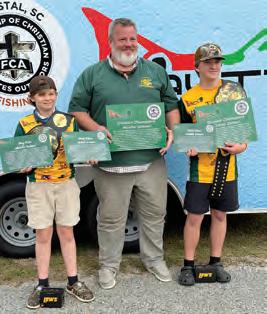
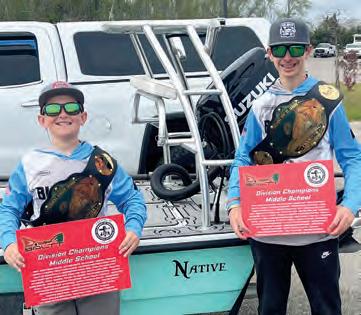
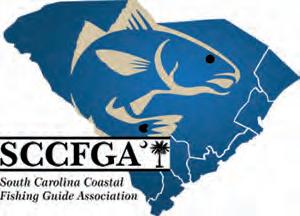
The South Carolina Coastal Fishing Guide Association (SCCFGA) is proud to announce its partnership with Release Over 20, a nationally recognized conservation initiative dedicated to protecting the future of inshore fisheries by encouraging anglers to release speckled trout and redfish over 20 inches in length.
This collaboration reflects our shared commitment to sustainable fishing practices and preserving the health of our coastal ecosystems for future generations. By joining forces with Release Over 20, SCCFGA members pledge to lead by example, educate clients, and support responsible catch-and-release practices that enhance fish populations and maintain the balance of our marine environments.
Together, we aim to make a lasting impact on conservation efforts along the South Carolina coast and inspire others in the fishing community to join this important movement.
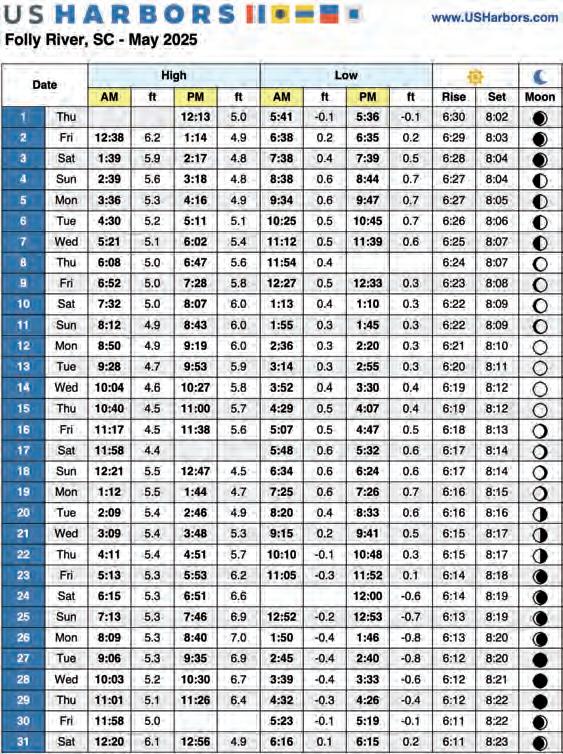

We want to say, Thank You to you and Amanda for your service to our Country. B est of luck o n your next adventure.

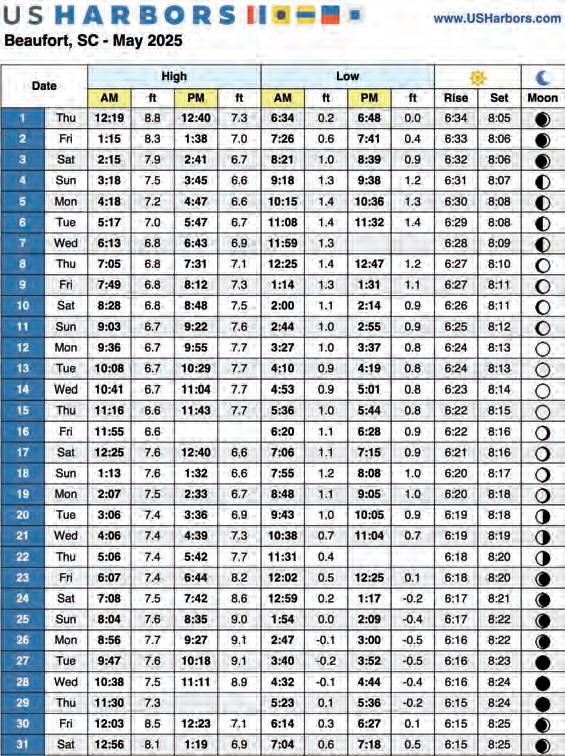
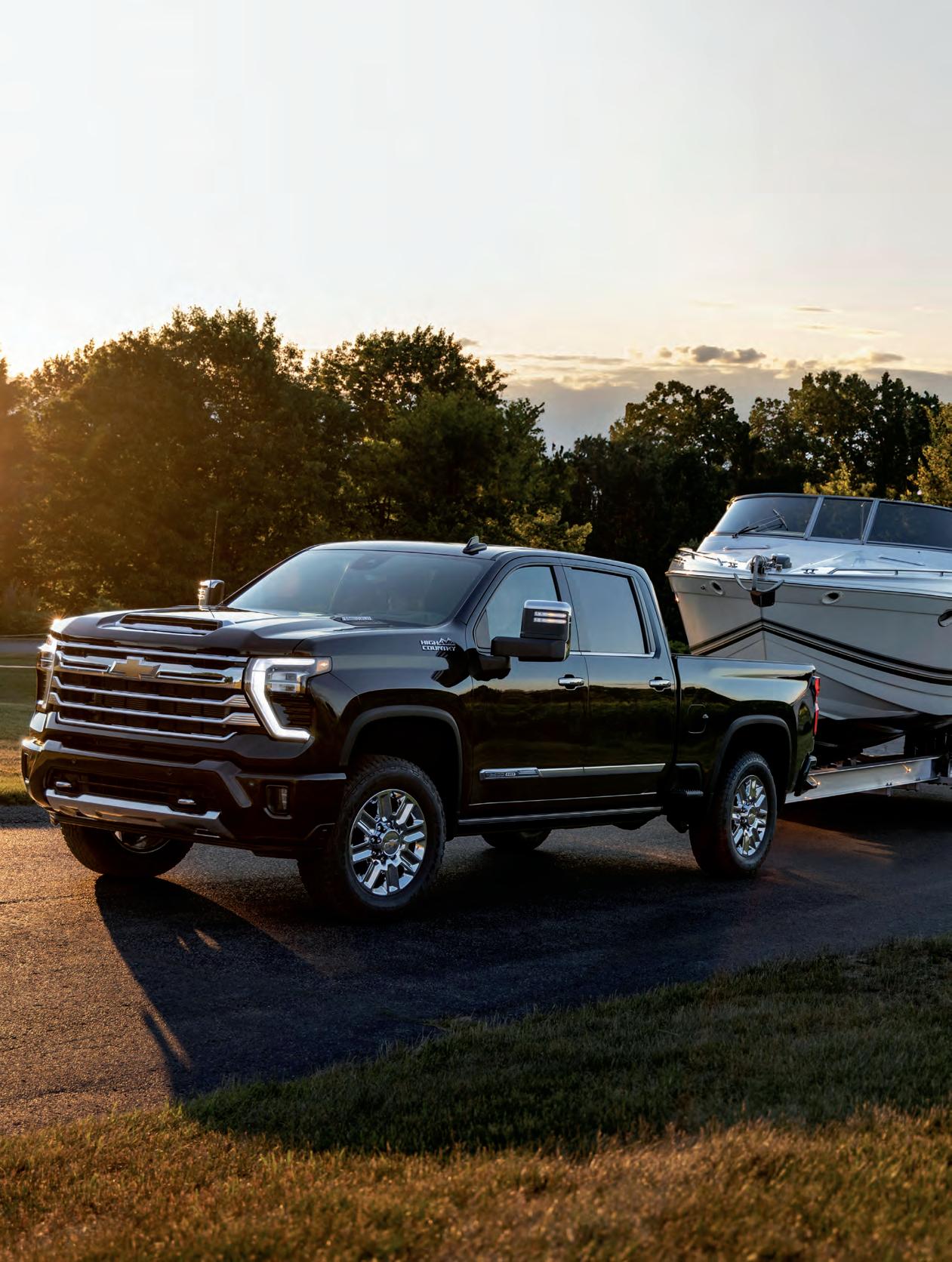

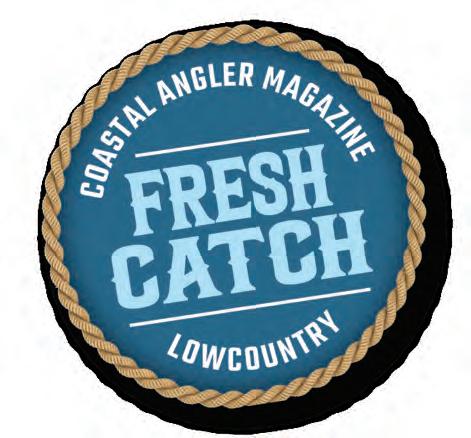

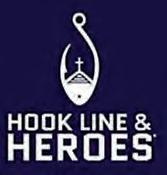
Hook, Line & Heroes
slayin’ them with Last Cast Charleston
Jasper, 6 years old, caught and released this 12-15in large mouth bass in Johns Island. SC with his kid's rod and reel all by himself! (fish size is a est. he wanted to put him back in the water)

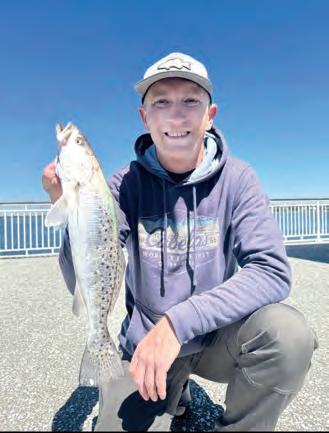

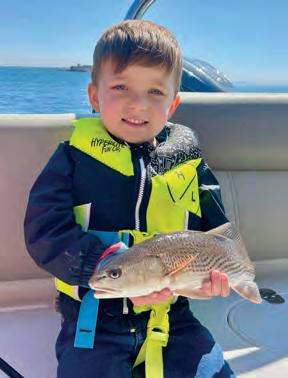
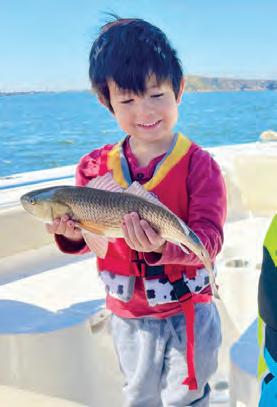
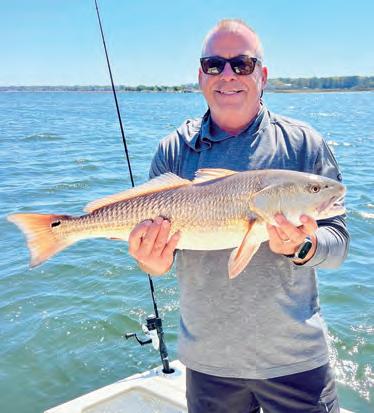






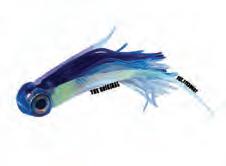


A!er breaking shermen’s hearts by releasing trophy grouper throughout the closed season, May is nally here, opening grouper season for anglers on the Atlantic Coast. I, for one, am thrilled to be able to add these tasty critters to the icebox yet again.
e red grouper is one of the most popular bottom sh found along the southeastern coast of the United States, particularly in the Gulf of Mexico and the Atlantic Ocean. It’s rm, white esh and rich avor make it a favorite for the majority of o%shore anglers. Easily recognizable by its reddish-brown coloration, the red grouper features scattered white blotches and a stocky body that suits its role as an ambush predator in rocky reef environments. Pulling one up from the depts that they exist in is the price you’ll pay to put this meat on your table because they’re also able to aggressively resist your will and challenge your strength. I like targeting them using live or cut bait. Once hooked, they tend to dive back into structure, which makes landing them a rewardingly brutal experience.
those who regularly bottom sh the overabundance seems to be more of a problem than the reduced stock assessments that NOAA has promoted.
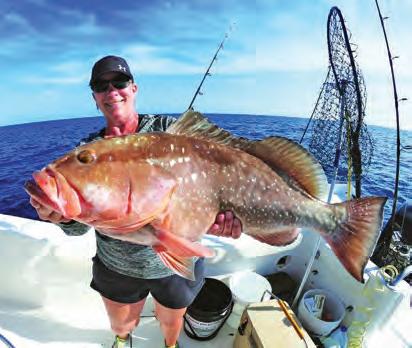
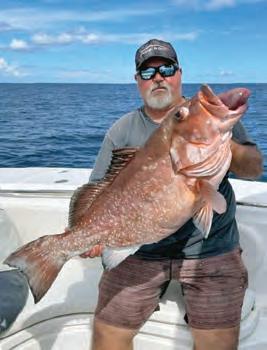
e National Oceanic and Atmospheric Administration (NOAA), has attempted to monitor stock assessments of red grouper, although many cite awed data in their forecasts. e catch limits and season closures that they’ve implemented have substantially reduced the angling communities’ opportunities to catch this highly sought a!er sh. For

I could be wrong, but it seems as if NOAA has become antirecreation-fishing oriented. eir policies and choice of data has created a distrust among many (most all) anglers these days. While ASA and numerous other angler organization have attempted to impact NOAA’s trend toward “Don’t Catch,” much remains to be done to correct the adversarial relationship between the American angler and this once highly respected organization. My small home town once had an animal control o cer that hated and abused stray dogs. Once the community brought this to the attention of local government o ce the problem got solved relatively quickly. ey red him. No more problem. Has it come time to re the management team of NOAA?
Disclaimer: e views and opinions expressed in this column are those of the writer and do not necessarily re ect the views or positions of Coastal Angler Magazine or any entities they represent.
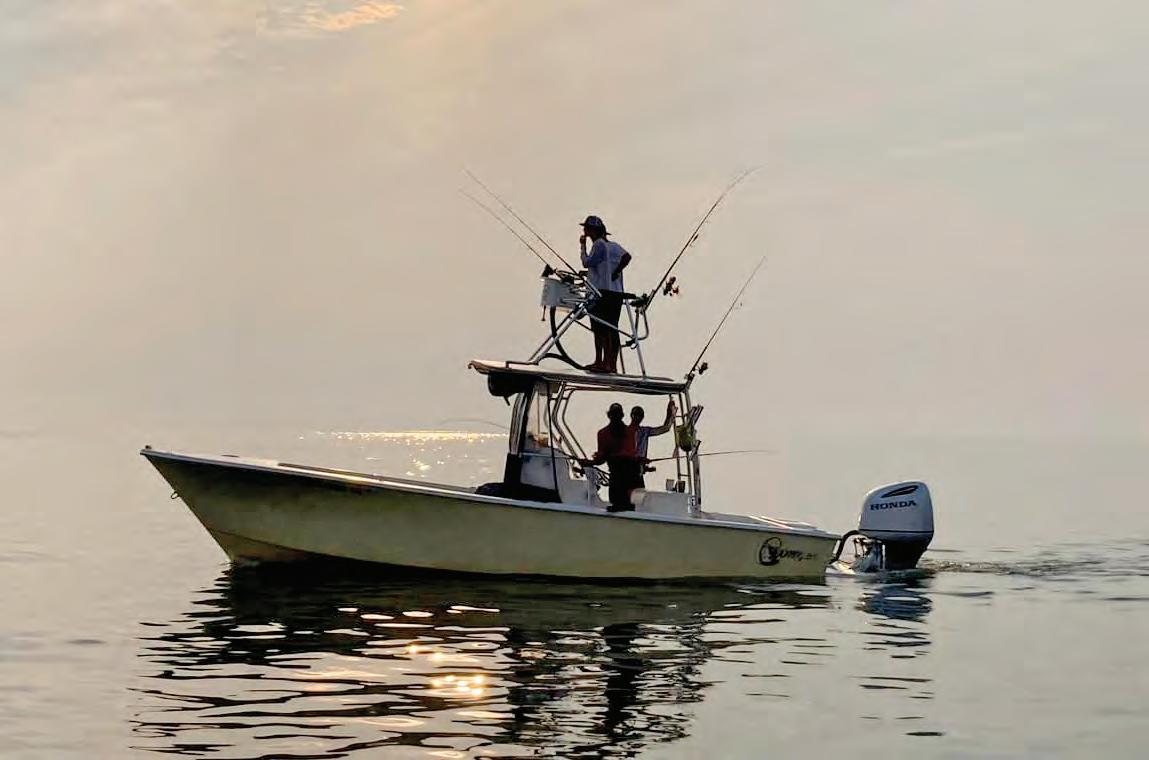
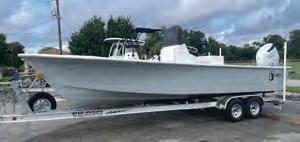
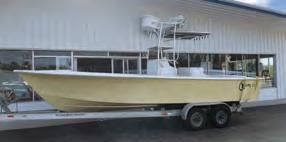
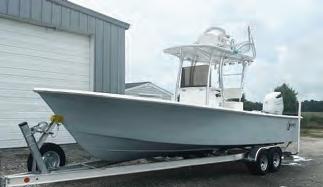



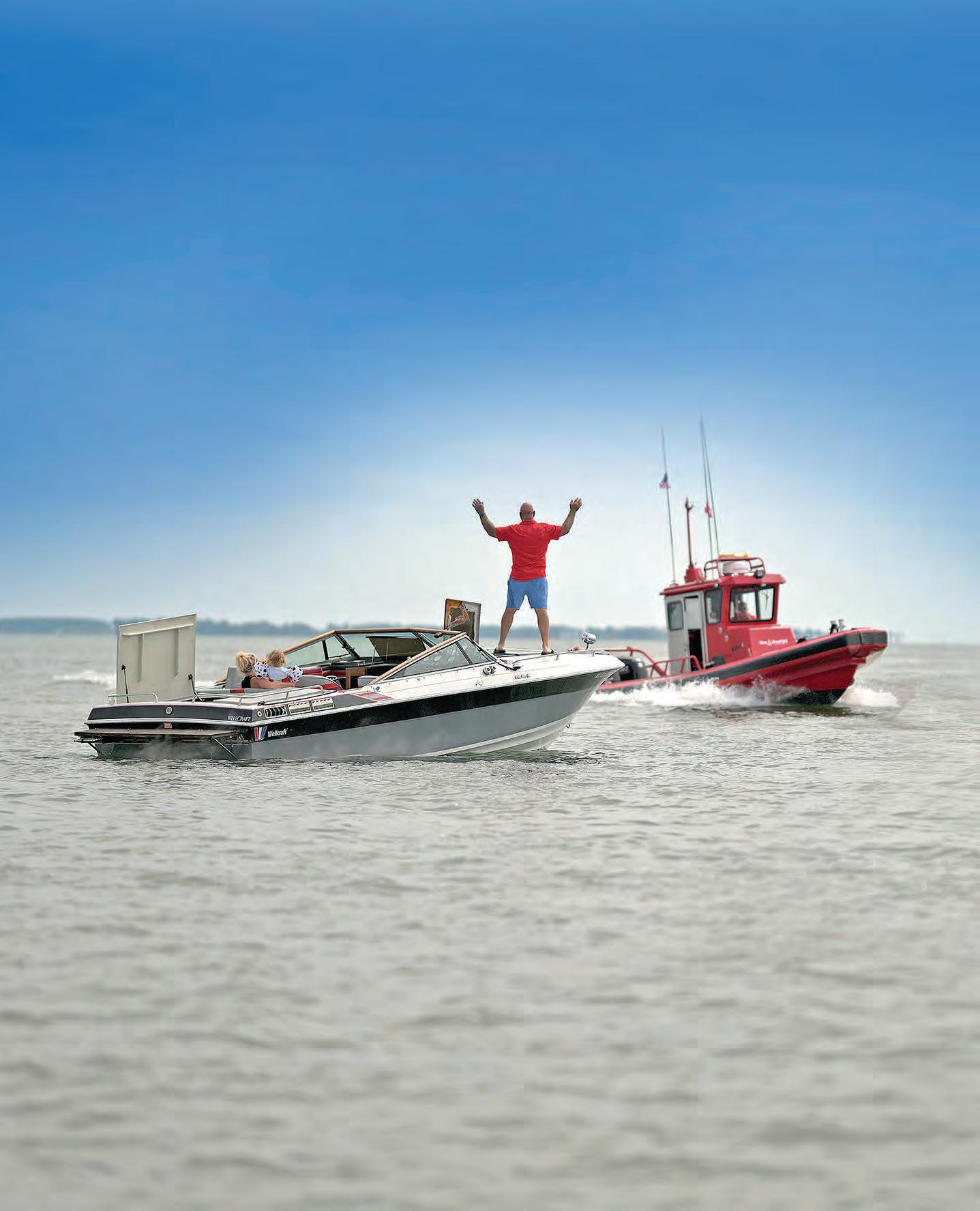



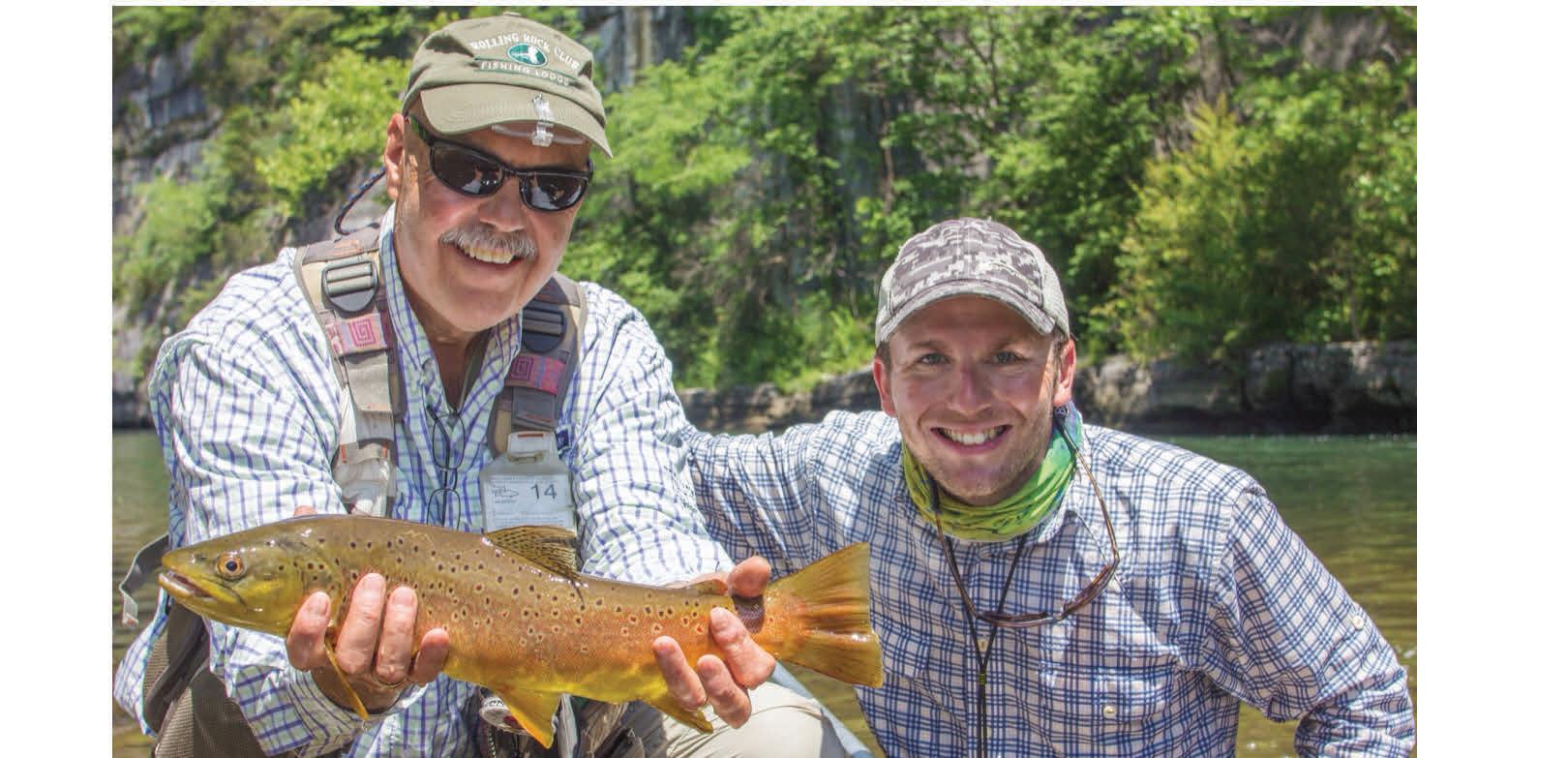



By Paul MacInnis
Catching channel cat sh can be a lot of fun and super rewarding—these guys ght hard! And the nice thing about cat shing is you don’t need fancy baits or tackle. If you want to target bullheads and smaller pan-sized cat sh you can use baits you gather right out of the river like grass shrimp and mussels. You can also use earth worms or small chunks of hotdog. Fish these baits on a 1/0 Aberdeen hook and add just enough split shot to your line to hold bottom.
But I prefer to target bigger channel cat sh, the bigger the better, using peeled shrimp for bait. You don’t need fresh shrimp, a bag of frozen shrimp from your local bait shop works ne. I also like to use cut bait as it holds up well to the bait stealers. Cut mullet or chunks from just about any sh work.
I use a standard sh nder rig. Run the line through a one-quarter to one ounce egg sinker, choosing just enough weight to hold bottom. Tie the line to a swivel and add about one to two feet of twenty pound test mono lament to the other end of the swivel. To the end of this leader I tie a 4/0 Team Cat sh TC84Z circle hook.
Baitcasting gear used for bass shing and 2000 to 3000 sized spinning tackle works ne for channel cats. You can get by with inexpensive mono lament, but I prefer a good quality 10-pound test braid like Platypus Platinum Plus. Braid won’t bow out as much as mono lament due to wind or current so it gives you a straighter connection between rod tip and bait. is kind of tackle can get sporty if a 10-pound-plus cat sh takes your bait, but sporty is exactly what I am looking for!




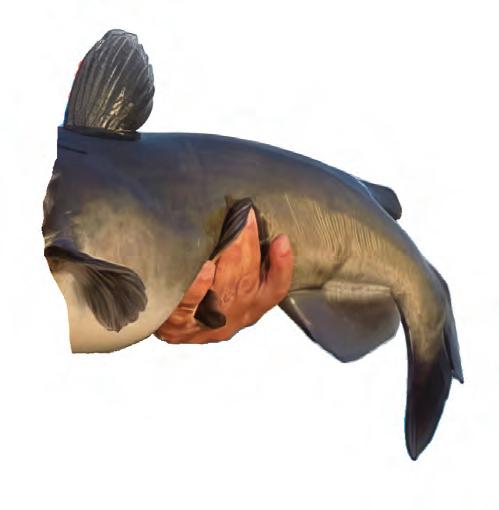

Popular wisdom says you should sh your baits in the deeper bends and holes. I shed that way for years and caught plenty of one to ve pound cat sh, but bigger sh eluded me. Many rivers (even lakes) are loaded with little coves and basins. I’ve learned if there is three feet or more of water in these basins there’s a decent chance there will be some nice cat sh there. I’ll park my kayak at the edge of the opening and cast a bait towards the center of the mouth of the cove, trying to place my bait in the slack water but close, within 10 feet or so, of the current. If I am feeling ambitious I’ll toss a second bait towards the back of the cove. Most of the time the biggest cat sh go for the bait close to the cove mouth...but that isn’t always the case. I like to let the circle hook do all the work so I’ll leave the rods in the rod holders until a sh puts a good bend in the rod and maybe even takes drag. Keep your ears open for loud splashes as channel cats will o!en thrash at the surface right a!er feeling the hook. Also watch your line. Cat sh don’t always take the bait going away from you. If your line goes slack or your bait changes position reel up tight and see if there is a sh on the line. Finally, if you start catching a lot of bow n you might want to move elsewhere (unless you like catching bow n) because I nd cat sh and bow n seldom share the same locations.
Channel cat sh can be aggressive predators and many a bass angler has been surprised when a big cat grabs their bass lure. Most of the time I wouldn’t advise tossing lures as an e cient way of targeting cat sh, but some years there is an exception that happens in spring into early summer. Winter and spring are typically dry season and water levels drop. Fish congregate in what deeper holes are le! and become aggressive due to high competition for food. is is one time when you can readily catch cat sh on lures and even ies. I like small plastic worms and other so! plastic baits bumped slowly along the bottom. Keep in mind cat sh are primarily scent feeders so dousing your lure with a decent sh scent helps.
During low water you’ll occasionally run across a real treat, a sandy bottom pool where you can spot cat sh and sight cast to them. I highly recommend a quality pair of polarized sunglasses with an amber tint and mirror coating to help you tell cat sh from gar and tilapia.
I suggest you give shing for channel cats a try, especially on those days when “game sh” don’t cooperate. Be patient, stay persistent, and enjoy the process!
When you rst drop your boat in the water, o!entimes it can be extremely overwhelming on where to sh and what to throw. One bait I have found in particular seems to catch bass at every lake I go to. is bait is a bladed jig, better known as a chatterbait. e bladed jig is a extremely versatile bait, meaning you can throw it around so many di%erent types of cover and sh it at many varying depths. It allows you to cover a vast amount of water and locate bass that would usually take days to nd with other baits.
As you approach a new lake or even one you have been to a thousand times, it’s always a good idea to throw a con dence bait that you know will get bites. e chatter-bait is mine. I’ve found that no matter the cover, grass, trees, docks, riprap, etc., it gets bit. With the blade on the front vibrating so erratically, it allows this bait to come through cover extremely well and creates a reaction strike no other bait can.
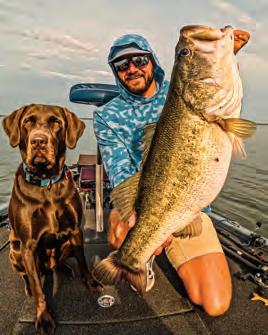
their home. Depending on the time of year and what kind of bait the bass are feeding on where you are shing, there is a color made to match the hatch. If shad is the prevalent forage, I like to stick to a white or a bait sh color like a pearl and silver with a silver colored blade. If it’s bluegill, you can get by with a green pumpkin or anything with some yellow and orange mixed in with a darker blade color. Sometimes water color can play a factor in color choice as well. If the water is very dirty, you will have to use a color that will stick out so that they can see it pass by. Something like a white and chartreuse with a white blade (for bait sh imitation) or even a bright orange with a black blade (for craw sh imitation) can do the trick.
TYLER WOOLCOTT

Buying a bladed jig and tying it directly on your rod usually isn’t too e%ective without putting a trailer on the back of it. I like to try and match the color of the trailer to the color of the skirt on your chatterbait of choice to get the most natural look for the sh. e type of trailer can be a bit more complicated. I use either a swimbait style trailer with a boot tail or a apping style trailer like a craw pattern. e boot tail stands out when sh are very aggressive and aren’t scared of the more aggressive action the boot tail causes behind the bait. e appy trailer is better for highly-pressured sh that want a little more of a subtle approach who might not like the amount of action a swimbait trailer has.
A chatterbait is a very dominant bait all across the country and I rely on this bait at all times of the year to help me put sh in the boat. Next time you hit the lake, give the chatter-baitt a try and cover some water!
Let’s talk about matching the chatterbait to the bait forage. By matching the color of the bladed jig to the forage in the lake, a bass can’t resist it as a nice snack when you reel it through
Sizes and weights of your bladed jig are extremely important. With sizes ranging from 1/4 oz. all the way to 1.25 oz., the depth you are shing will decide what you tie on. I typically start with a 3/8 oz. or a 1/2 oz. which will allow you to cover water depths from 1 to 10 feet depending on your retrieve. If I nd some deeper cover that i want to get down to and sh, I will go a little heavier to a 3/4 oz.

Whether you’re fishing in a kayak, canoe, or small boat, the ePropulsion eLite 500W redefines your on-water experience with innovative features and commitment to sustainability. Designed to be the most compact and lightweight electric outboard in its class, it is an easy-to-use alternative to small internal combustion engines for enthusiasts worldwide. Max 5.6 miles at half throttle and 3.5 miles at full throttle.
BLADED JIG GEAR: When throwing a bladed jig its important to have the correct gear. I use a 13 Fishing Myth Rod 7’5 MH-mod paired with a 13 Fishing Concept A 7:5:1 reel. I spool this up with 17 lb. Su x Advance Fluorocarbon line making this the perfect combo for the job.
Tyler Woolcott is a professional tournament angler and guide. Check out his website at www.tylerwoolcott shing.com.
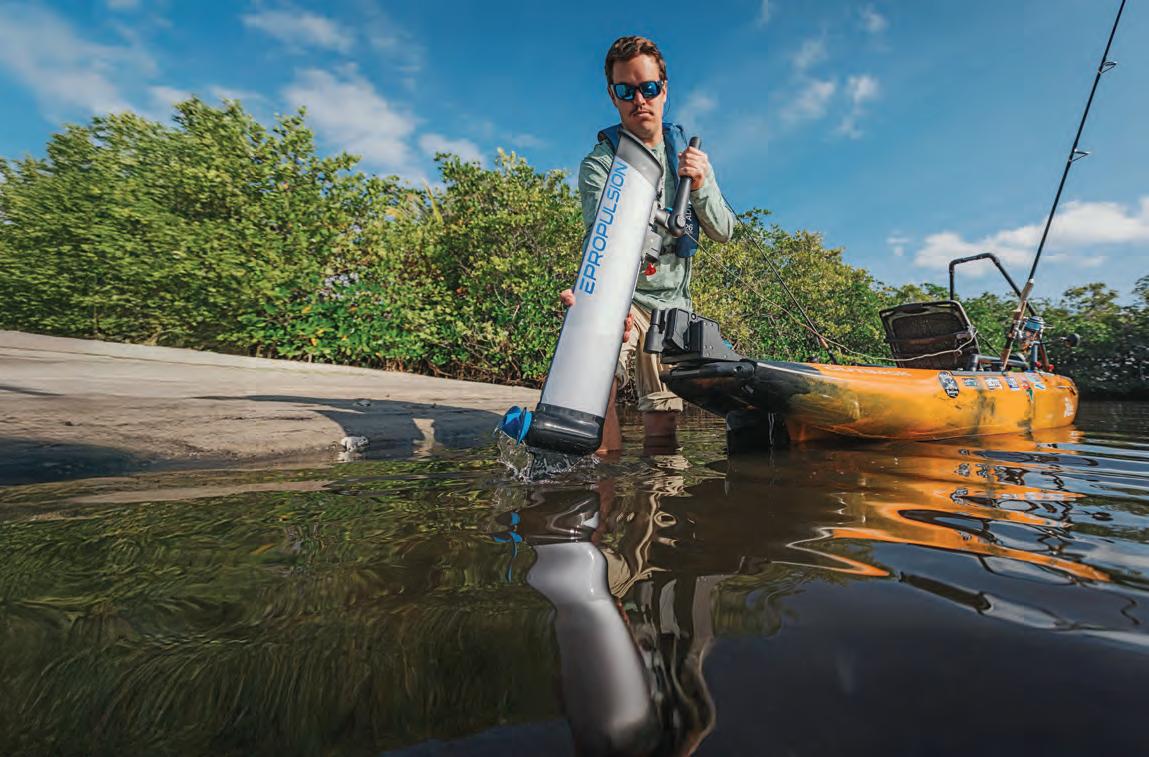





— Gene H.

Switzerland is synonymous with expensive, big-name luxury watches like Rolex®, Piaget® and Patek Philippe® that sell for thousands, but the Stauer Swiss Tactical Watch delivers Swiss precision for a fraction of the cost. Inspired by military timepieces like the American A-11, it combines rugged performance, simplicity, and legendary craftsmanship — built for action, not display cases.
Precision Takes Time
Swiss excellence demands patience. Each Stauer Swiss Tactical takes nearly nine months to complete, and this is a limited edition of 4,900. Crafted by master watchmakers, some of whom have worked with the other prestigious brands, this is your chance to own a rare, precision-engineered tactical watch without the inflated luxury price tag.
Why Pay for a Name?
Big brands charge more for status. Stauer delivers the same quality and precision with high-contrast markers for instant readability, a shock-resistant case to withstand hard knocks and Swiss-made movement for impeccable timing.
Limited Offer – Act Now
Don’t miss this rare combination of Swiss craftsmanship and unbeatable value. Only 4,900 available — once they’re gone, they’re gone.
Why pay more when you can own precision, heritage, and adventure for less? Order now — time is running out.
Watch Speci cations:
• Made in Switzerland with precision Swiss Ronda 515 movement. Stainless steel caseback. Brown leather band
• 44 mm diameter case. Date window at 3 o’clock
• Water-resistant to 3 ATM. Fits wrists up to 8 ¼”
Stauer Swiss Tactical Watch
$399 $59* + S & P Save $340
*Special price only for
APort Arthur, TX angler and his friends recently achieved an extraordinary feat— reeling in an enormous 884-pound blue n tuna.
On April 10, David Esslinger and his friends were shing in the Gulf when the massive sh struck his line with incredible force. He had no idea he was about to embark on the most intense battle of his shing career. ankfully, Esslinger had an eager crew by his side, ready to assist in landing this remarkable sh.
“Let me break down the day and the events for you. First o%, for those who have never landed a sh the size of a car, this is no small feat. No one accomplishes this alone,” Esslinger posted on Facebook.
e group set out early Friday morning. By 9 a.m., a!er a couple of hours of shing, they started noticing signs of a school of tuna breaking the surface of the calm waters. Suddenly, the right rigger snapped down with a forceful bite, signaling the start of Esslinger’s showdown against his monstrous tuna.
Esslinger recalls, “Big tuna started breaking the surface and our team’s spirits began to li! at’s when it happened—the right rigger came down hard. e sh ran about ten seconds and spit the 12/0 mustad hook and the bait. As my heart sank,
I came up on the drag and gave her 10 cranks. As soon as I engaged the clicker again the giant sh piled on again. at’s when the rst 3/4 spool run at 35 pounds of drag started.”
Realizing what was at stake, his team quickly got into position for the ensuing battle, clearing lines and the deck.
“I had to crank it up to 45 pounds of drag on the Tiagra to slow her down. She responded with a rush to the surface. Carson was at the helm with Brad, TC, Je%, and Colby, coordinating everything e ciently from cockpit to helm. We managed to get the sh up to the surface in just over an hour,” stated Esslinger.
A!er an exhausting ve-hour battle of strength and endurance, Esslinger and his crew nally brought the massive blue n alongside the boat. With shaking body and inoperable hands, Esslinger made his way to the side of the boat and screamed with utter shock, “What a giant blue n! We did it!”
is impressive catch is seen as a trophy sh among anglers, celebrated for its enormous size and high-quality meat. And it was indeed enormous. Weighing in at 884 pounds, this blue n tuna has set a new state record for the largest tuna caught in Texas, surpassing the previous record of 876 pounds established by Troy Lancaster in 2021.


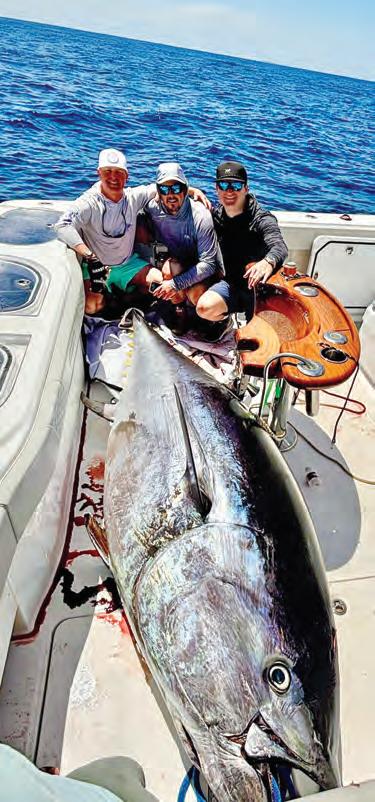

By CAM Sta
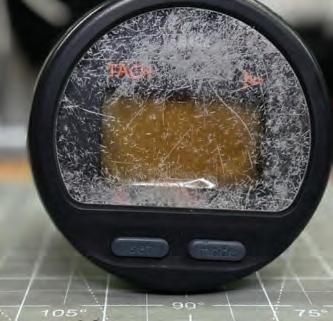



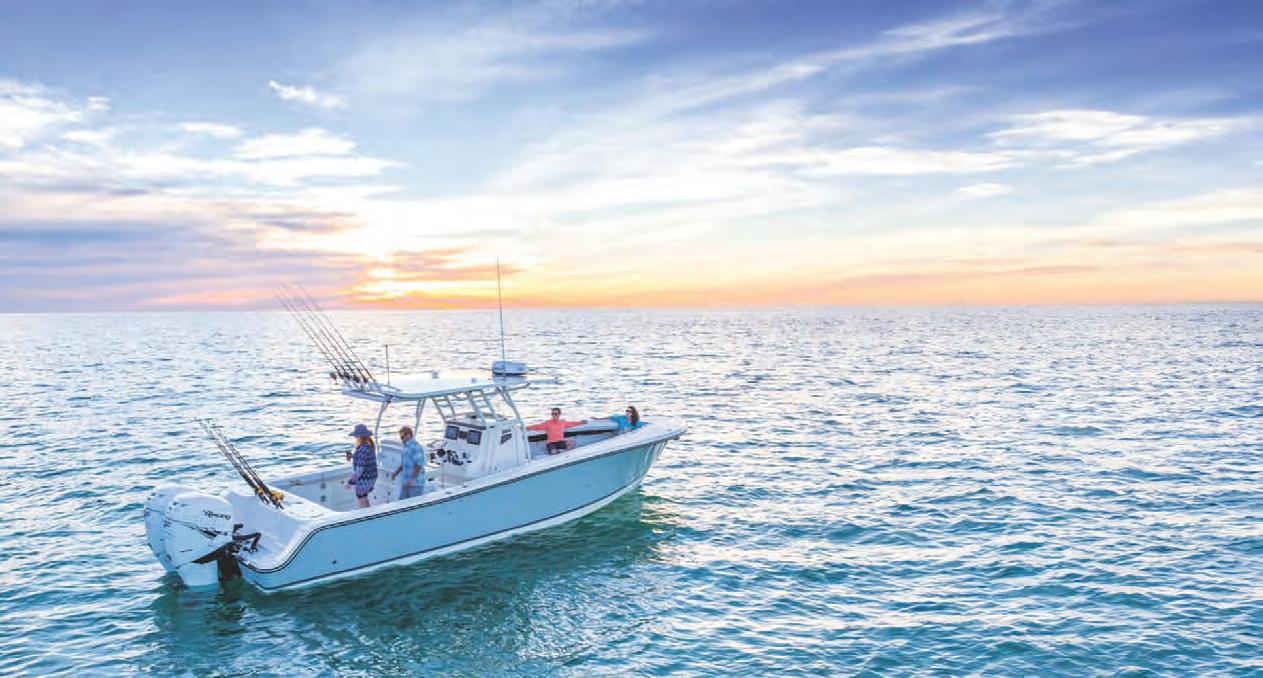


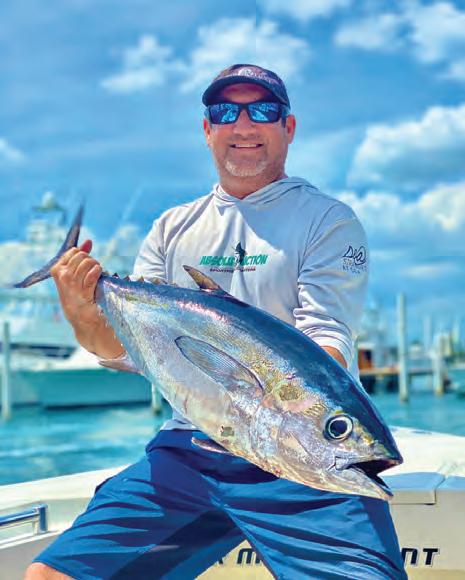






You want AI Routing! Let TZ MAPS with AI Routing make route planning a snap. Don’t take our word for it. Scan here to see for yourself how easy it is!